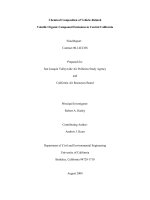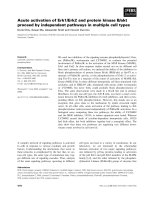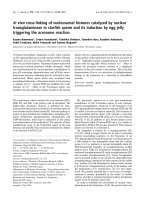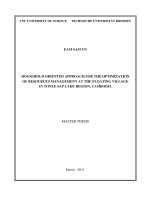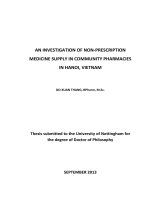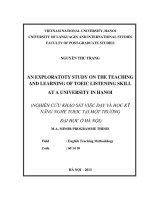Proximate composition of household waste and applicability of waste management technologies by source separation in Hanoi, Vietnam
Bạn đang xem bản rút gọn của tài liệu. Xem và tải ngay bản đầy đủ của tài liệu tại đây (1.07 MB, 10 trang )
J Mater Cycles Waste Manag (2016) 18:517–526
DOI 10.1007/s10163-014-0348-5
ORIGINAL ARTICLE
Proximate composition of household waste and applicability
of waste management technologies by source separation in Hanoi,
Vietnam
Kosuke Kawai • Luong Thi Mai Huong
Masato Yamada • Masahiro Osako
•
Received: 25 January 2014 / Accepted: 21 December 2014 / Published online: 1 January 2015
Ó Springer Japan 2014
Abstract The organic fraction of municipal solid wastes
in Southeast Asia, which has a high moisture content,
accounts for a large proportion of total waste. Local
governments need to pay adequate attention to the composition of wastes to determine alternative waste management technologies. This study proposed the use of a
triangle diagram to describe changes in proximate composition and rates of successful source separation of
municipal solid waste and to identify technical challenges
about alternative waste management technologies such as
incineration, composting, and refuse-derived fuel production based on physical and proximate composition analysis of household waste sampled in Hanoi, Vietnam, as a
case study. The analysis indicated the effectiveness of
different types of source separation as well as different
levels of successful achievement of source separation as
an adjustment mechanism for the proximate composition
of waste. Proper categorization of wastes for source separation is necessary for the appropriate use of alternative
waste management technologies. The results showed that,
at a source separation rate of just greater than 0.52 in a
three-way separation scheme, the waste separated as
combustible waste would be suitable for incineration with
energy recovery. Based on well-designed schemes of
K. Kawai (&) Á M. Yamada Á M. Osako
Center for Material Cycles and Waste Management Research,
National Institute for Environmental Studies, 16-2 Onogawa,
Tsukuba, Ibaraki 305-8506, Japan
e-mail:
L. T. M. Huong
Institute for Urban Environment and Industry of Vietnam,
56/221, De La Thanh, Dong Da, Hanoi, Vietnam
source separation, alternative waste management technologies can be applied.
Keywords Household waste Á Source separation Á Waste
management technology Á Proximate composition Á
Developing country
Introduction
In Southeast Asia, municipal solid waste is usually collected without source separation or pre-treatment and
transported directly to landfills or open dumping sites, most
of which are rarely technically managed because of budget
constraints [1]. Heavy rainfall, combined with poor management of disposal sites, allows a great deal of untreated
leachate to leak into the aquatic environment near the sites.
Moreover, poor municipal solid waste management results
in methane emissions, which are generated in the process
of biodegradation of organic waste in the tropical climate
of Southeast Asia and have a greenhouse effect about 21
times greater than that of carbon dioxide. Local governments in Southeast Asian countries have struggled to
extend the lifespan of current disposal sites and to secure
new ones as the amount of waste collected has increased
dramatically because of rapid population and economic
growth in urban areas.
Various life cycle assessment (LCA) models have
evaluated the environmental performance of municipal
solid waste management facilities and clarified the disadvantages of poorly managed landfills as compared with
alternative waste management technologies [2, 3]. Alternative waste management technologies such as incineration, composting and refuse-derived fuel (RDF) production
can reduce the volume of municipal solid waste to be
123
518
disposed of at landfill sites. Incineration can also generate
electricity if the heating value of the wastes is sufficient,
composting can produce organic fertilizers that can substitute for chemical fertilizers and RDF can substitute for
natural resources consumed as fuel [4]. With some
exceptions such as the Phuket treatment facility in Thailand
[5] and others in Singapore [6, 7], large-scale incineration
facilities for municipal solid waste management are rare in
Southeast Asia, although some major cities have recently
begun to consider installing them [8, 9]. Composting or
aerobic biological treatment has been applied at the community and neighborhood level as well as at the city level
as a component of a mechanical biological treatment
(MBT) system [10, 11]. The Bangkok Metropolitan
Administration in Thailand has also started producing RDF
as a component of MBT [12].
Local governments face many difficulties when replacing landfills with alternative waste management technologies because of technical constraints, and even if
alternatives can be implemented, landfills cannot be entirely
replaced because remaining residues will still need to be
landfilled. The organic fraction contains high moisture
content and accounts for a large proportion of municipal
solid waste in Southeast Asia [13–16]. The high moisture
content may encumber the operation of waste management
technologies and require additional fuel and materials or
pre-treatment processing [17]. Previous LCA studies [5,
18–20] that have evaluated the environmental performance
of municipal solid waste management systems employing
alternative waste management technologies in Southeast
Asia assumed that the alternative technologies were applicable, without any consideration of basic qualitative
parameters for operation of technologies, for example, the
proximate composition of the waste (moisture, volatile, and
ash contents). Local governments in Southeast Asia need to
pay adequate attention to the characteristics of their municipal solid waste to determine whether alternative waste
management technologies are appropriate for the waste.
This study proposed the use of a triangle diagram to
confirm whether the current proximate composition of
municipal solid waste would be suitable for incineration,
composting and RDF production by using physical and
proximate composition analyses of household waste in
Hanoi, Vietnam, as a case study. This study also identified
technical challenges of municipal solid waste management,
showing the ranges of change in proximate composition on
triangle diagrams as related to varying levels of successful
achievement of three types of source separation of household waste. Note that this study did not account for other
relevant aspects, such as the chemical properties of waste
and financial feasibility, which are also important in discussions regarding the adoption of new waste management
systems in developing countries.
123
J Mater Cycles Waste Manag (2016) 18:517–526
Materials and methods
Physical and proximate composition analysis
Household waste was sampled from four urban districts
(Ba Dinh, Hoan Kiem, Dong Da, and Hai Ba Trung districts; Fig. 1) in Hanoi. We selected eight collection points
of municipal solid waste from the four districts (two per
district) on a random basis and requested the cooperation of
community leaders and municipal solid waste collection
workers in sampling waste from households. Discarded
household waste is collected daily in the evening in Hanoi,
and we sampled household waste from the eight collection
points every evening from 17:00 to 19:00 for 8 days from
25 November to 3 December 2011 except for 1 December,
when sampling was not conducted because of rain. A total
of 828 kg of waste was collected from 339 households
(1252 residents), which was equivalent to approximately
0.12 % of the population in the four districts (1,055,800
residents [21]). Each day, the samples were immediately
transported to a roofed area at the Cau Dien Composting
Site located 10 km west of the center of Hanoi city.
Ideally, the physical composition analysis should be
conducted promptly after sampling because the moisture
content of wet wastes such as food waste is highly likely to
leach into other types of wastes such as paper. However,
waste samples were stored for a half day because of
practical limitations involved with doing the work at night.
The physical composition analysis was therefore conducted
every morning from 8:00 to 10:00 on the previous day’s
Nam Son landfill site
Hoan Kiem
Urban districts
Ba Dinh
Cau Dien composting site
Dong Da
Hai Ba Trung
Hanoi
10 km
Vietnam
Fig. 1 Map of Hanoi, Vietnam
J Mater Cycles Waste Manag (2016) 18:517–526
collected samples. Six workers manually sorted all waste
samples into 16 physical categories of waste: paper, plastic,
glass, and metals as salable waste; and food, garden, paper,
plastic, wood, textiles, rubber and leather, glass, metals,
coal ash, ceramics, and other materials as unsalable waste.
Coal ash is the residue from burning coal briquettes for
cooking. This is a commonly used fuel source in Hanoi
[22], but it is not a common characteristic of household
waste in other Southeast Asian countries. In some countries, coal ash is classified as a hazardous waste because of
its relatively high heavy metal content. Paper, plastics,
glass, and metals are usually regarded to be salable
resources, but very wet or dirty paper products, broken
glass, plastic bags, and greasy aluminum foil were categorized as unsalable. The proportion of salable waste to
total waste in the samples was probably lower than the
actual proportion because only waste that was certain to
have a market value was regarded as salable in this study,
and some salable waste may have been miscategorized as
unsalable. After the waste samples had been sorted into the
16 categories, they were weighed with a digital scale (CJ8200, Shinko Denshi Co., Ltd., Tokyo, Japan) with a
minimum reading of 0.1 g. The weights were verified to
detect data entry errors by comparing the total weight
before and after sorting.
Proximate composition data (data on moisture, volatile,
and ash contents) of all categories of waste samples were
obtained twice during the 8-day sampling period, and the
average values of each waste category served as a basis of
estimation of changes in proximate composition of
household waste after source separation. The following
procedure was used to analyze proximate composition.
Samples of each of the 15 waste types (excluding ‘‘other’’)
were reduced to approximately 100 g each by the conical
quartering method. The reduced sub-samples were dried in
a laboratory drier at 85 °C for 3 days to measure the
moisture content. Although an authorized method in Japan
[23] states that samples should be dried at 105 °C for
moisture content measurements, we used 85 °C to prevent
the plastic sample from melting. The dried samples were
burned at 800 °C for 2 h in an incinerator to measure
volatile (i.e., combustible) and ash contents. We did not
estimate the volatile content of glass, metals, and ceramics,
which were categorized as non-combustible. The average
proximate composition of all 11 unsalable waste samples
was substituted for that of the ‘‘other’’ category.
Moisture, volatile, and ash contents of household waste
were calculated with Eqs. 1, 2 and 3, respectively
X Wi  Mi
WH ¼
ð1Þ
100
X Vi  M i
ð2Þ
VH ¼
100
519
AH ¼
X Ai  M i
100
ð3Þ
;
where WH is moisture content of household waste (%), Wi
is moisture content of waste category i (%), Mi is physical
composition of waste category i (%), VH is volatile content
of household waste (%), Vi is volatile content of waste
category i (%), AH is ash content of household waste (%),
and Ai is ash content of waste category i (%).
We detected a notable transfer of water from food waste
to unsalable paper and plastic waste because it took at least
a half day to initiate the analysis of the moisture content of
the wastes after sampling. To simulate the original moisture
content of the wastes before the water transfer resulting
from the delay, we adjusted the moisture content of unsalable paper and plastic waste to match those of salable ones,
which were found to contain much less moisture. The
moisture content of food waste was then correspondingly
increased. The ratios between volatile and ash content in
food and unsalable paper and plastic waste were maintained
at the same values before and after the adjustment. Some
parameters include uncertainties as a result of various factors. The effects caused by these uncertainties should be
considered in our analysis. In particular, moisture content in
household waste plays a significant role when determining
the applicability of waste management technologies.
Therefore, in the presentation of results, uncertainty in
moisture content was shown as a range when visualizing the
ranges of change in proximate composition of household
waste depending on achievement levels of source separation. Uncertainty of moisture content of all waste categories
ranged from -5 to 5 % of the average measured value, and
proximate composition based on the uncertainty was calculated with Eqs. 4, 5, and 6, respectively:
X Wi  ð1 Æ U Þ Â Mi
WHU ¼
;
ð4Þ
100
X f100 À Wi  ð1 Æ U Þg  Vi  Mi
VHU ¼
;
ð5Þ
ðVi þ Ai Þ Â 100
AHU ¼
X f100 À Wi  ð1 Æ U Þg  Ai  Mi
ðVi þ Ai Þ Â 100
ð6Þ
;
where WHU is moisture content of household waste based on
uncertainty (%), U is the uncertainty of moisture content for
all waste categories, VHU is volatile content of household
waste based on uncertainty (%), and AHU is ash content of
household waste based on uncertainty (%). The uncertainty
of moisture content changes at the same time for all categories of waste within a defined range (U 0:05).
Scenarios and achievement rate of source separation
Source separation of household waste is regarded as a
fundamental policy of waste management in Japan. Each
123
520
local government designs its own categories of source
separation in line with local policies and conditions.
Municipalities have depended largely on incineration
technology for municipal solid waste management; almost
all municipalities have combustible waste (usually
including food waste) as a category of source separation. In
addition to combustible waste, containers and packaging
wastes such as cardboard, beverage bottles, and aluminum
cans are also often collected separately. Less commonly,
some municipalities collect food waste separately for
composting or anaerobic digestion. Because categories of
source separation in Japan vary from municipality to
municipality, new residents may initially be confused at the
sometimes complicated and unique categories of source
separation.
In this study, we propose three source separation scenarios, all of which are designed to be easy to understand.
In scenario I, household waste was separated into two
types: combustible waste for incineration or RDF production and non-combustible waste for landfilling. In scenario
II, household waste was also separated into two types:
biodegradable waste for composting and non-biodegradable waste for incineration or landfilling. In scenario III,
household waste was separated into three types: combustible waste for incineration or RDF production, non-combustible waste for landfilling, and biodegradable waste for
composting.
Because it would be almost impossible in practice for all
people to perfectly separate their household waste, we
defined the ‘‘achievement rate of source separation’’ as the
proportion of the actual separation rate (x). When household waste is separated into two types (A and B; corresponding to scenarios I and II), some of the waste
categorized as A will be appropriately separated as A (x),
but some will be inappropriately separated as B (1 À x)
(Fig. 2). In scenarios I and II, the achievement rate was
assumed to range from 0.5 to 1.0, and an achievement rate
of 0.5 implies that sorting is random and that waste separated as A will be of the same quality as waste separated as
B. An achievement rate of 0.7 in scenario I, for example,
represents the situation in which 0.7 of combustible waste
by weight is appropriately separated as combustible waste,
and the remaining 0.3 by weight is incorrectly included as
non-combustible waste. An achievement rate of 1.0 means
that all household waste is perfectly separated. When
household waste is separated into three types (A, B, and C;
corresponding to scenario III), we assumed that the rate of
inappropriate separation was ð1 À xÞ Â 0:5 (Fig. 3). In
scenario III, the achievement rate was assumed to range
from 0.33 to 1.0, and an achievement rate of 0.33 implies
that sorting is random and that waste separated as A will be
of the same quality as waste separated as B and C. The
achievement rates of source separation of waste
123
J Mater Cycles Waste Manag (2016) 18:517–526
Waste categorized as A
Waste categorized as B
Separated
as A
Separated
as B
Separated appropriately
Separated inappropriately
Fig. 2 Achievement rate of source separation (x) for two waste
categories to be separated
Waste categorized as A
Separated
as A
Waste categorized as C
Separated
as B
Separated
as C
Waste categorized as B
Separated appropriately
Separated inappropriately
Fig. 3 Achievement rate of source separation (x) for three waste
categories to be separated
categorized as A, B, and C were set as a single parameter to
simplify the case study.
Taking into account the uncertainty in the measurements
of moisture content, the ranges of change in the proximate
composition shown on the triangle diagrams in the results
represent achievement rates ranging from 0.5 to 1.0 in
scenarios I and II and from 0.33 to 1.0 in scenario III. In
Japan, almost all municipalities treat food and garden
waste at incineration plants. Food and garden waste were,
therefore, categorized as combustible waste in scenario I
following the waste management practice in Japan and as
biodegradable waste in scenarios II and III (Table 1). Paper
J Mater Cycles Waste Manag (2016) 18:517–526
521
Table 1 Types and categories of household waste based on scenarios of source separation
Scenario
I
Types
Combustible
Categories
Food
Garden
Paper
Plastic
Wood
Textiles
Rubber
and
leather
4
4
4
4
4
4
4
Biodegradable
Non-biodegradable
4
4
4
4
4
III
Combustible
4
4
4
4
4
Ceramics
4
4
4
4
4
4
4
4
4
4
4
4
Other
materials
4
4
Non-combustible
4
Coal
ash
4
II
Biodegradable
Metals
4
Non-combustible
4
Glass
4
4 Included
and wood waste were not categorized as biodegradable
waste in scenarios II and III because of the much longer
time period required for biodegradation as compared with
food and garden waste.
Proximate composition boundaries
and
12; 570\210 Â V:
ð12Þ
Equation 13 shows the moisture content boundary for
truck unloading, moving heavy equipment, and covering
soil during landfilling (Fig. 8):
ð13Þ
W\85:
Each waste management technology has application limits
depending on the proximate composition of the particular
type of waste [24]. This study adopted the range limits of
Tanaka et al. [25] as follows.
Equation 7 shows the ranges of volatile content and
moisture content for the self-sustaining combustion of
waste (Fig. 4), and Eq. 8 shows the ranges of them for
energy recovery by incineration (Fig. 5):
3352\HL ¼ ð210 Â V Þ À ð25 Â W Þ;
ð7Þ
6285\HL ¼ ð210 Â VÞ À ð25 Â WÞ
ð8Þ
Results and discussion
Physical and proximate composition
Food waste was the largest component of household waste,
accounting for 57.3 % of total waste; it also had the highest
moisture content (76.1 %; Table 2). The average moisture,
volatile, and ash contents for the household waste collected
were 57.7, 24.1, and 18.2 %, respectively. Coal ash
where HL is lower heating value (kJ kg-1), V is volatile
content (%), and W is moisture content (%).
Equation 9 shows the range of the moisture content that
allows sufficient oxygen and water supply for aerobic
digestion for composting, and Eq. 10 shows the relationship between moisture and volatile content that allows
moisture to evaporate with aerobic metabolic heat (Fig. 6):
50\W\70
100
80
60
ð9Þ
40
and
25 Â W\168 Â V Â 0:5:
Equation 11 shows the moisture content boundary for
RDF production at which it is not necessary to install a pretreatment facility for drying waste, and Eq. 12 shows the
volatile content boundary at which waste is available as
fuel above 12,570 kJ kg-1 of higher heating value (Fig. 7).
W\20
20
ð10Þ
ð11Þ
Application range of
incineration
3352 < HL (kJ kg -1)
0
Volatile (%)
Fig. 4 Application range of incineration for varying sets of proximate composition. HL is lower heating value. The shaded area
indicates the area, where the technology is feasible given the
proximate conditions
123
522
J Mater Cycles Waste Manag (2016) 18:517–526
100
100
80
80
60
60
40
40
Application range of
20 incineration with
energy recovery
6285 < HL (kJ kg -1)
0
20
0
Application range
of RDF production
Volatile (%)
Volatile (%)
Fig. 5 Application range of incineration with energy recovery for
varying sets of proximate composition. HL is lower heating value. The
shaded area indicates the area, where the technology is feasible given
the proximate conditions
Fig. 7 Application range of RDF production for varying sets of
proximate composition. The shaded area indicates the area where the
technology is feasible given the proximate conditions
100
100
80
80
60
60 Application range
of composting
40
40
Application range of landfilling
20
20
0
0
Volatile (%)
Volatile (%)
Fig. 6 Application range of composting for varying sets of proximate
composition. The shaded area indicates the area where the technology is feasible given the proximate conditions
accounted for 11.3 % of household waste by weight and
was categorized as non-combustible waste in consideration
of its relatively low volatile content (6.7 %) and high ash
content (81.1 %). This analysis indicated that the use of
coal briquettes for cooking had a considerable effect on the
physical and proximate composition of household waste in
Hanoi. However, coal briquettes are expected to be
replaced in the near future by propane gas as living conditions improve. In that case, a much smaller amount of
coal ash would be generated by households. The moisture
content of paper and plastics sorted as unsalable waste
exceeded 50 %, most likely because of transfer of moisture
123
Fig. 8 Application range of landfilling for varying sets of proximate
composition. The shaded area indicates the area where the technology is feasible given the proximate conditions
content from food waste. Salable waste accounted for only
3.6 % of the total, and the moisture content of the paper
and plastics sorted as salable waste was much lower, less
than 10 % in each case. As stated previously, the actual
proportion of salable waste may have been higher because
the sorting criteria of physical composition analysis were
very conservative. Household hazardous wastes such as
syringes, fluorescent lamps, and dry-cell batteries were
observed during the physical composition analysis, but the
proportion was very small and the items were included in
the appropriate category (i.e., syringes, plastic; fluorescent
lamps, glass; and dry-cell batteries, metal).
J Mater Cycles Waste Manag (2016) 18:517–526
Table 2 Physical and
proximate composition of
household waste sampled in
Hanoi (%)
Categories
523
Physical composition
Proximate composition
Moisture
Volatile
Ash
13.0
Salable
Paper
0.8
8.3
78.7
Plastic
1.4
7.3
90.8
1.9
Glass
0.9
0.2
0.0
99.8
Metals
0.5
3.6
0.0
96.4
Unsalable
Food
57.3
76.1
18.5
5.4
Garden
3.4
72.9
22.6
4.5
Paper
6.4
55.2
38.8
5.9
Plastic
8.2
53.4
42.1
4.5
Wood
Textiles
1.0
1.9
27.2
13.5
65.3
84.2
7.5
2.4
Rubber and leather
0.2
3.2
81.5
15.2
Glass
0.6
0.6
0.0
99.4
Metals
0.1
8.2
0.0
91.8
Coal ash
11.3
12.3
6.7
81.1
Ceramics
0.7
0.5
0.0
99.5
Other materials
5.3
29.4
32.7
37.9
Table 3 shows the adjusted proximate composition of
food, unsalable paper, and plastic waste simulating the
original composition before the transfer of water from food
waste to the paper and plastic waste. The moisture content
of food waste increased from 76.1 to 88.0 % corresponding
with the adjustment of the moisture contents of unsalable
paper and plastic waste from 55.2 to 8.3 % and 53.4 to
7.3 %, respectively. These adjusted values were utilized for
estimating the changes in proximate composition of
household waste in line with source separation achievement as discussed in the next section.
incineration plants with energy recovery and at RDF production plants.
Figure 10 shows the ranges of change in proximate
composition of household waste according to achievement
rate of source separation for scenario I (household waste
was separated into combustible and non-combustible
waste). Moisture and volatile content of the waste separated as combustible waste showed little change as the
achievement rate increased, and the lower heating value of
the combustible waste peaked at 3571–4774 kJ kg-1 when
the achievement rate was set at 1.0. Source separation of
100
Scenarios and changes in proximate composition
The lower heating value of household waste in Hanoi was
estimated to be 3591 kJ kg-1 by Eq. 7, which is barely
greater than the level necessary for self-sustaining combustion (Fig. 9). The high proportion of food waste with its
high moisture content reduced the lower heating value.
Figure 9 illustrates that additional drying would be necessary to manage current household waste in Hanoi at
80
60
40
20
Table 3 Adjusted proximate composition of food, and unsalable
paper and plastic waste (%)
Categories
Moisture
Volatile
Food
88.0
9.3
2.7
Paper
8.3
79.6
12.2
Plastic
7.3
83.7
9.0
0
Ash
Volatile (%)
Fig. 9 Current proximate composition of household waste in Hanoi
(filled diamond). The solid lines inside the triangle diagram reflect the
boundaries of respective waste management technologies
123
524
J Mater Cycles Waste Manag (2016) 18:517–526
100
100
1.0
80
80
1.0
0.5
60
0.5
60
0.5
0.5
40
40
20
20
1.0
1.0
0
0
Volatile (%)
Volatile (%)
Separated as combustible waste
Separated as non-combustible waste
Fig. 10 Range of changes in proximate composition of household
waste at various achievement rates of source separation in scenario I
(shaded areas). The lines inside shaded areas reflect proximate
composition at 0.1 intervals of achievement rates from 0.5 to 1.0
household waste with a high proportion of food and garden
waste, as presented in scenario I, would not be effective in
increasing the heating value of the waste. Furthermore, this
scenario suggests that food and garden waste, which have a
high moisture content, should not be included in the waste
to be incinerated given the current waste composition in
Hanoi. In addition, the volatile content of the coal ash
prevents the volatile content of the waste separated as noncombustible waste from reaching zero.
The triangle diagram for scenario II (household waste
was separated into biodegradable and non-biodegradable
waste, Fig. 11) shows that the applicability of incineration
of the waste separated as non-biodegradable waste rises
with increases in the achievement rate. Because the moisture content of the waste separated as biodegradable waste
increased as the achievement rate increased, it would be
necessary to add water-conditioning agents such as rice
husks and rice straw to the composting process to adjust the
moisture content of the waste. Fortunately, it would be
relatively easy to secure these materials in Vietnam, which
is a major producer of rice. Although we categorized paper
and wood waste as non-biodegradable waste in this study,
they are actually biodegradable in the long term and absorb
moisture, prevent odors under anaerobic conditions, and
increase air circulation [4]. To successfully apply incineration with energy recovery, the achievement rate needs to
be greater than 0.74 for the waste separated as non-biodegradable waste. The maximum lower heating value of
the waste separated as non-biodegradable waste was
9600–9763 kJ kg-1 at an achievement rate of 1.0. Even
with an achievement rate of 1.0, the volatile content of the
123
Separated as biodegradable waste
Separated as non-biodegradable waste
Fig. 11 Range of changes in proximate composition of household
waste at various achievement rates of source separation in scenario II
(shaded areas). The lines inside shaded areas reflect proximate
composition at 0.1 intervals of achievement rates from 0.5 to 1.0
100
1.0
80
0.5
60
0.5
0.5
40
20
1.0
1.0
0
Volatile (%)
Separated as combustible waste
Separated as non-combustible waste
Separated as biodegradable waste
Fig. 12 Range of changes in proximate composition of household
waste at various achievement rates of source separation in scenario III
(shaded areas). The lines inside shaded areas reflect proximate
composition at an achievement rate of 0.33 and at 0.1 intervals of
achievement rates from 0.4 to 1.0
waste separated as non-biodegradable waste did not meet
the criteria for RDF production.
Figure 12 shows the triangle diagram for scenario III
(household waste was separated into combustible, noncombustible, and biodegradable waste). The ranges of
change in the proximate composition of the waste separated
as combustible waste were ideally distributed to be treated
J Mater Cycles Waste Manag (2016) 18:517–526
with incineration. At higher source separation rates, moisture
content decreased and the amount of volatile matter
increased. To successfully apply incineration with energy
recovery, the achievement rate needs to be just greater than
0.52 for the waste separated as combustible waste. When the
achievement rate exceeded 0.92, the waste separated as
combustible waste could be applied for RDF production. The
maximum lower heating value of the waste separated as
combustible waste was 14,498–14,729 kJ kg-1 at an
achievement rate of 1.0.
Conclusion
This study analyzed the effect of source separation on
changes in proximate composition of household waste in
Hanoi, Vietnam, and on the applicability of alternative
waste management technologies with triangle diagrams.
Proper categorization of wastes for source separation is
necessary if alternative waste management technologies
are to be used successfully. The results showed that the
two-way separation scheme categorizing household waste
into biodegradable and non-biodegradable waste (scenario
II) was more effective to apply for incineration with energy
recovery than that of the scheme categorizing household
waste into combustible and non-combustible waste (scenario I). At a source separation rate of just greater than 0.52
in the three-way separation scheme presented in scenario
III, the waste separated as combustible waste would be
suitable for incineration with energy recovery; moreover,
the waste could be applied for RDF production with an
achievement rate of greater than 0.92. Therefore, welldesigned source separation schemes should be an important
component of alternative waste management technologies.
This study focused only on the proximate composition
to evaluate the applicability of alternative waste management technologies to landfilling, but other aspects should
also be studied to strengthen the utility of the analytical
tool. After composting and RDF production, the processed
wastes will be sold and distributed as secondary resources.
To produce reliable and safe products, wastes input in the
processes must meet chemical criteria, such as pH and
concentration of heavy metals and chloride [26]. Financial
feasibility is especially important in discussions regarding
the adoption of new waste management systems in developing countries.
The triangle diagram allows the visualization of the
proximate composition of separated wastes and can contribute to decision-making to improve municipal solid
waste management. Any local government can apply this
type of analysis if they have data on the physical and
proximate composition of waste in their local areas.
Appropriate methods for continuously recording data on
525
the physical and proximate composition would make the
use of the triangle diagram even more reliable. Periodic
sampling at regular intervals must be done carefully to be
representative of local wastes and result in reliable composition data. Historical data can aid in estimating a reasonable range of waste composition.
Local governments will not be able to implement successful source separation systems without the cooperation
of their residents. Although pilot-scale source separation
systems have been attempted in Hangzhou in China [27],
Hanoi in Vietnam [28] and Hatyai in Thailand [29], cityscale systems have rarely been established in developing
countries. Local governments in these countries have to
develop effective strategies to involve residents in the
source separation systems not simply by importing systems
that have already been applied in developed countries, but
by taking into consideration local factors such as customs,
economic conditions, culture and religion.
Acknowledgments We sincerely thank Nguyen Huu Dung of the
Institute for Urban Environment and Industry of Vietnam and all the
staff of the International Cooperation Department, Hanoi Urban
Environment Company for supporting this study. We express our
sincere and profound gratitude to the Environment Research and
Technology Development Fund by the Ministry of the Environment,
Government of Japan.
References
1. Memon MA (2010) Integrated solid waste management based on
the 3R approach. J Mater Cycles Waste Manag 12:30–40
2. Cleary J (2009) Life cycle assessments of municipal solid waste
management systems: a comparative analysis of selected peerreviewed literature. Environ Int 35:1256–1266
3. Winkler J, Bilitewski B (2007) Comparative evaluation of life
cycle assessment models for solid waste management. Waste
Manag 27:1021–1031
4. McDogall F, White P, Franke M, Hindle P (2001) Integrated solid
waste management: a life cycle inventory, 2nd edn. Blackwell
Science, Oxford
5. Liamsanguan C, Gheewala SH (2008) The holistic impact of
integrated solid waste management on greenhouse gas emissions
in Phuket. J Clean Prod 16:1865–1871
6. Khoo HH, Lim TZ, Tan RBH (2010) Food waste conversion
options in Singapore: environmental impacts based on an LCA
perspective. Sci Total Environ 408:1367–1373
7. Bai R, Sutanto M (2002) The practice and challenges of solid
waste management in Singapore. Waste Manag 22:557–567
8. Bangkok Metropolitan Administration (2012) Bangkok State of
the environment 2010–2011. Bangkok Metropolitan Administration, Bangkok
9. Kathirvale S, Yunus MNM, Sopian K, Samsuddin AH (2003)
Energy potential from municipal solid waste in Malaysia. Renew
Energ 29:559–567
10. Pasang H, Moore GA, Sitorus G (2007) Neighbourhood-based
waste management: a solution for solid waste problems in
Jakarta, Indonesia. Waste Manag 27:1924–1938
11. Muttamara S, Visvanathan C, Alwis KU (1994) Solid waste
recycling and reuse in Bangkok. Waste Manag Res 12:151–163
123
526
12. Nithikul J, Karthikeyan OP, Visvanathan C (2011) Reject management from a mechanical biological treatment plant in Bangkok, Thailand. Resour Conserv Recy 55:417–422
13. Damanhuri E, Wahyu IM, Ramang R, Padmi T (2009) Evaluation
of municipal solid waste flow in the Bandung metropolitan area,
Indonesia. J Mater Cycles Waste Manag 11:270–276
14. Shekdar AV (2009) Sustainable solid waste management: an
integrated approach for Asian countries. Waste Manag
29:1438–1448
15. Thanh NP, Matsui Y, Fujiwara T (2010) Household solid waste
generation and characteristic in a Mekong Delta city, Vietnam.
J Environ Manag 91:2307–2321
16. Troschinetz AM, Mihelcic JR (2009) Sustainable recycling of
municipal solid waste in developing countries. Waste Manag
29:915–923
17. Wilson DC, Rodic L, Scheinberg A, Velis CA, Alabaster G
(2012) Comparative analysis of solid waste management in 20
cities. Waste Manag Res 30:237–254
18. Aye L, Widjaya ER (2006) Environmental and economic analyses of waste disposal options for traditional markets in Indonesia.
Waste Manag 26:1180–1191
19. Chaya W, Gheewala S (2007) Life cycle assessment of MSW-toenergy schemes in Thailand. J Clean Prod 15:1463–1468
20. Gunamantha M, Sarto (2012) Life cycle assessment of municipal
solid waste treatment to energy options: case study of Kartamantul region, Yogyakarta. Renew Energ 41:277–284
123
J Mater Cycles Waste Manag (2016) 18:517–526
21. Hanoi Statistical Office (2011) Hanoi statistical yearbook 2010.
Hanoi Statistical Office, Hanoi
22. Kawai K, Osako M (2011) Estimation of recyclable waste flows in
Hanoi, Vietnam (in Japanese). Environ Sanit Eng Res 25:21–29
23. Ministry of Health and Welfare of Japan (1977) Protocol of waste
analysis, Notification of Kansei 95th (in Japanese). Ministry of
Health and Welfare of Japan, Tokyo
24. World Bank (1999) Municipal solid waste incineration, World
Bank technical guidance report. World Bank, Washington, DC
25. Tanaka N, Matsuto T, Kakuta Y, Tojo Y (2003) Fundamental
knowledge of waste management engineering for recycling and
appropriate disposal (in Japanese). Ghihodoshuppan, Tokyo
26. Jakobsen ST (1995) Aerobic decomposition of organic wastes 2.
Value of compost as a fertilizer. Resour Conserv Recy 13:57–71
27. Zhuang Y, Wu SW, Wang YL, Wu WX, Chen YX (2008) Source
separation of household waste: a case study in China. Waste
Manag 28:2022–2030
28. Japan International Cooperation Agency, Yachiyo Engineering
Co., Ltd, Nippon Koei Co., Ltd (2009) Project completion report
of the project for implementation support for 3R initiative in
Hanoi city to contribute to the development of a sound materialcycle Society in the Socialist Republic of Vietnam. Japan International Cooperation Agency, Tokyo
29. Charuvichaipong C, Sajor E (2006) Promoting waste separation
for recycling and local governance in Thailand. Habitat Int
30:579–594
